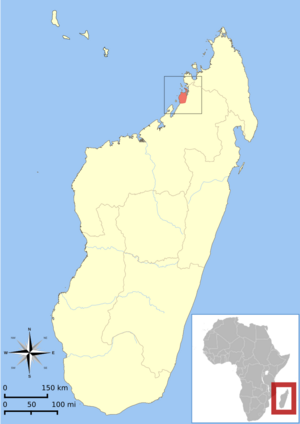Sahamalaza sportive lemur facts for kids
Quick facts for kids Sahamalaza sportive lemur |
|
|---|---|
 |
|
| Conservation status | |
| Scientific classification | |
 |
|
| Distribution of L. sahamalaza | |
| Synonyms | |
|
The Sahamalaza sportive lemur (Lepilemur sahamalaza) is a type of sportive lemur. It lives only in northern Madagascar.
Contents
About the Sahamalaza Sportive Lemur
What is a Sportive Lemur?
Sportive lemurs belong to a family with just one group, called Lepilemur. Scientists are still learning about how these lemurs are related to each other. They use genetic analysis to figure out new species.
The Sahamalaza sportive lemur was once thought to be the same as the Gray-backed sportive lemur (L. dorsalis). But in 2006, scientists realized it was a different species. It was officially described in 2017. Its name changed from Lepilemur sahamalazensis to Lepilemur sahamalaza that same year.
What Does it Look Like?
The Sahamalaza sportive lemur is active at night. This means it has big orange eyes that help it see in the dark. These lemurs weigh about 700 to 900 grams (1.5 to 2 pounds). Female lemurs can be up to 200 grams (0.4 pounds) heavier than males.
From head to body, they are about 26 centimeters (10 inches) long. Their tail is also about the same length. Their fur is a mix of grey and red-brown. The color can change depending on the light or how old the lemur is. Their belly fur is lighter, from grey to creamy white. They have a very good sense of smell. The tip of their nose is wet and sensitive.
Where Do They Live?
Home in Madagascar
The Sahamalaza sportive lemur lives only on the Sahamalaza Peninsula in northwestern Madagascar. This area is a mix of two different forest types.
Sadly, people have cut down many trees on the peninsula. There are no longer any large, untouched forests. Instead, the lemurs live in five smaller pieces of forest. The Ankarafa forest is one of the most studied parts. It has semi-humid forest with trees up to 25 meters (82 feet) tall.
Preferred Habitat
Sahamalaza sportive lemurs like places with many trees. They also prefer areas where the tree branches form a thick roof, called a canopy. This gives them many safe places to sleep. The weather here changes with the seasons. It is cool and dry from May to October. Then it becomes hot and rainy from November to April.
How They Live
What Do They Eat?
Most of what sportive lemurs eat is leaves. But they also enjoy fruits, flowers, tree sap, bark, and small bugs. It is unusual for animals that eat mostly leaves to be active at night. This is because leaves have less sugar at night. Plants make less sugar when there is no sunlight.
Sportive lemurs have a very slow metabolism. This means their bodies use energy very slowly. This helps them survive on a diet of low-energy leaves. Some scientists think these lemurs might even eat their own poop. This helps them get all the nutrients they need from their food.
Daily Behavior
The Sahamalaza sportive lemur mostly lives in trees. It moves between trees by making long jumps using its strong back legs. If it goes on the ground, it hops like a kangaroo. They are quite noisy at night.
During the day, they hide among leaves or in holes in tree trunks. When they rest in tree holes, they like to be near the entrance. This lets them feel the sunlight. At night, they spend about 47% of their time resting. They spend 18% of their time eating.
These lemurs usually live alone. They strongly defend their home area from other lemurs of the same sex. However, the home areas of males and females can overlap. Sportive lemurs can be inactive for about half of their waking time. They can rest without moving much for up to two hours at a time. On average, they travel only about 343 meters (1,125 feet) each night. Being inactive helps them digest their low-quality food. It also helps them save energy.
Staying Safe from Predators
The Sahamalaza sportive lemur listens to alarm calls from other animals. These calls warn them about predators. Scientists proved this with an experiment. When they played the sound of a harrier hawk (a bird that hunts lemurs), the lemurs became more alert. They looked up at the sky.
Dangers They Face
Natural Threats
The Malagasy tree boa can hunt the Sahamalaza sportive lemur while it sleeps during the day. Birds of prey can also hunt them when they are out in the open.
Human Threats
The biggest dangers from humans are habitat loss and hunting. People cut down forests for wood. They also hunt the lemurs for food. Wildfires, which happen from May to October, also harm their homes. The Sahamalaza - Iles Radama National Park was created to help protect them.
Protecting the Sahamalaza Sportive Lemur
Conservation Efforts
In 2007, a study estimated there were about 3,000 sportive lemurs in total. This number included different types of lemurs, not just this species. The International Union for Conservation of Nature (IUCN) now lists the Sahamalaza sportive lemur as critically endangered. This means it is at a very high risk of disappearing forever. However, it is believed that their numbers have grown because of protection efforts.
Groups like the Association Européenne pour I'Etude et la Conservation des Lémuriens (AEECL) have worked since 2001. They helped create the Sahamalaza - Iles Radama National Park. In September 2001, the Sahamalaza Peninsula became a UNESCO biosphere reserve. This means it is a special place for both people and nature. A partnership with the Wildlife Conservation Society (WCS) also helped make the protection program well-known.
The main goal of AEECL's work is to make sure that critically endangered lemurs, like the blue-eyed black lemur and the Sahamalaza sportive lemur, have safe homes away from human activity.


